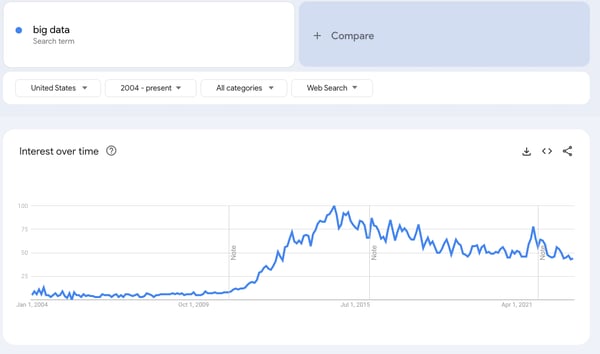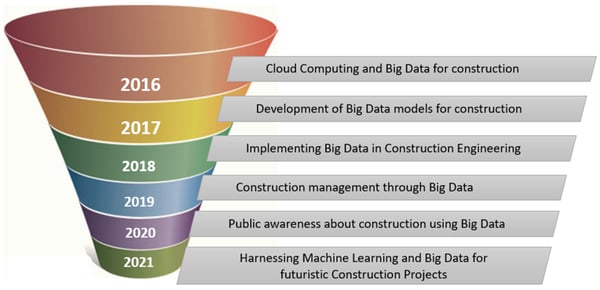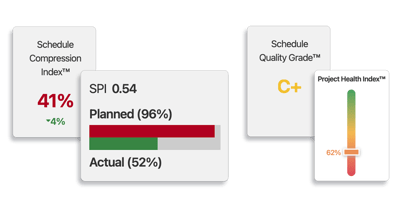The amount of data generated today is unprecedented. 86% of the United States population owns a smartphone, which creates massive amounts of data daily. Think of the pictures you take, the directions you look up, the apps you download, and everything you search online. As 2023 is already in full swing, the construction industry can use the power of some of this big data to rebuild how it operates.
What Is Big Data?
Big data refers to processing large amounts of information, including storage, management, processing, interpretation, and visualization. It is often used to create unique big-data strategies that help organizations make quality business decisions. The benefits of these decisions no doubt contribute to the high monetary value of big data. Just recently, the value of data was expected to increase by $30 Billion from 2021-2022, making it one of the most valuable goods in the world.
Although the concept of big data was popularized in other industries over a decade ago, its use in construction is relatively new. However, its benefits and potential have long been recognized. A 2012 study by IBM and the Saïd Business School at the University of Oxford highlights how big data can transform processes, organizations, industries, and society.

Data Source: Google Trends
And, while the interest in the words “big data” peaked almost a decade ago, its use in construction is actively being pursued today. Why nearly a decade later? As a recent study in Big Data and Cognitive Computing1 points out, the research and development of industry-specific, big data computer processing methods weren’t available until 2016.

Figure 1. Funnel Diagrams showing trends in Big Data Research in Construction since 2016.
Despite these developments, the construction industry lags in realizing big data’s potential value. For instance, Tesla leverages both artificial intelligence (AI) and big data analytics for self-driving cars. And, while you might be a skeptic about the capacity of a vehicle to operate without direct human interaction, the number of injuries and accidents typically caused by human error can be significantly reduced.
What if the construction industry also leveraged the technological capabilities of computing systems and big data analytics to reduce human error?
The State of Big Data in Construction
Forbes’ 2016 article, “How Big Data and Analytics Are Transforming the Construction Industry,” states, “Over the next five years, Big Data and analytics will radically transform both the process of construction and the business of construction contracting.”
“If you look at companies today, most of them are not very good at using the data they have to make better decisions in real-time,” Michael Dell
However, it’s been seven years since that article was published, and the core challenges faced by the industry are still present. That same year, a Bloomberg article referred to an IDC prediction that embedded data analytics would provide U.S. enterprises with $60+ billion in annual savings by 2020. Yet, according to PlanGrid and FMI Corp, the industry wastes more than $177 billion annually. Almost 3x the amount of proposed savings are spent on processes like rework, conflict resolution, and looking for project data. A more recent source, AGC’s Construction Technology 2023 Market Update: On the Cusp of Brick-and-Mortar Revolution (Once Again),” poses several other reasons contributing to inefficient big data processing systems, such as:
- The multitude of constituents, workflows, unique segment processes, and constant change create an inherently challenging ecosystem.
- Construction IT budgets averaged approximately 1% of annual sales volume in 2021.
- Increasing costs cause razor-thin margins.
- Legacy mindsets and aversion to broad-reaching technological adoption remain entrenched.
The Largely Untapped Benefits of Data Analytics in the Construction Industry
By using real-time data and analytics, big data processing systems can help teams identify and address problems as they arise. Big data analytics are also often used to optimize resource allocation, improve safety, and minimize risk.
Take a look at how data can improve the way construction companies operate, as proposed by Software Advice:
- More accurate quoting and bidding
- Reduces human error
- Improves timelines and hits deadlines
- Mitigates risk to workers
- Fosters predictability throughout a project
While all these benefits can undoubtedly increase construction project success, the most important one on the list is the reduction in human error. Everybody makes mistakes–human error is simply an innate biological trait. Remember the study that found the biggest challenge facing the industry to be poor job site coordination? Well, all that boils down to communication issues. With all the barriers to effective communication–such as work environments, distractions, and emotional states–ineffective job site coordination is simply a human error.
That is where big data steps in. Partnering with your data and all the available technology eliminates many common project problems. You just need to see that data in a way that tells a story to communicate it effectively and in real time.
How to Present Big Data in Construction
With the large amount of data generated daily, society is in a state of information overload. It’s no different when communicating obstacles to your teams, as they often go unnoticed.
Many predictive technologies utilize big data sets to alert users of upcoming roadblocks. However, a pop-up message or an email might not get the point across. We are constantly bombarded with messages, and our brains cannot process them.
What our brains are excellent at, though, is pattern recognition, which is why data visualization is so important.
Data visualization is essential in the digital age because of the overwhelming amount of information. Using charts, graphs, and other visualizations, big data can be presented in a way that is easy to understand. This makes it possible to identify patterns and trends that would otherwise go unnoticed.
Example of Data Visualization
One of the most significant data sets in construction is the project schedule. The schedule lists all the activities needed to complete a project, assigns tasks to teams, and includes durations and dates for activity completion. It’s instrumental in detecting project problems and areas of opportunity. However, the data is not always presented intuitively.
When it is, the data tells a very informative story. SmartPM digests schedule data, producing impactful visualizations that give a detailed understanding of project performance and success.
For example, when compression is in the red, you know that you need to discuss adding additional resources or increasing the project scope. The simple visualization of the risky compression level allows for better communication and real-time collaboration.

Using big data analytics tools, all the data–from stakeholders, emails, texts, photos, blueprints, schedules, budgets, and historical data–can be used to achieve the ultimate goal: completing projects within their intended timeframe and scope. This not only benefits the construction industry but other industries as well.
The Possibilities Are Endless
The complex web of people involved in a project extends outside the construction realm. Many different industries can reap their rewards from better big-data utilization in construction:
- Law firms use insights to analyze contracts and identify risks or opportunities.
- Insurance companies use big-data analytics from construction to assess risk and calculate premiums.
- Real estate companies can benefit by identifying investment opportunities and trends.
- Venture capitalists utilize construction big data to identify promising startups that help solve industry problems.
The possibilities are endless. The construction industry just needs to catch up with the big data revolution to innovate and change the way it operates. In doing so, the industry faces fewer challenges – and so do many others.

